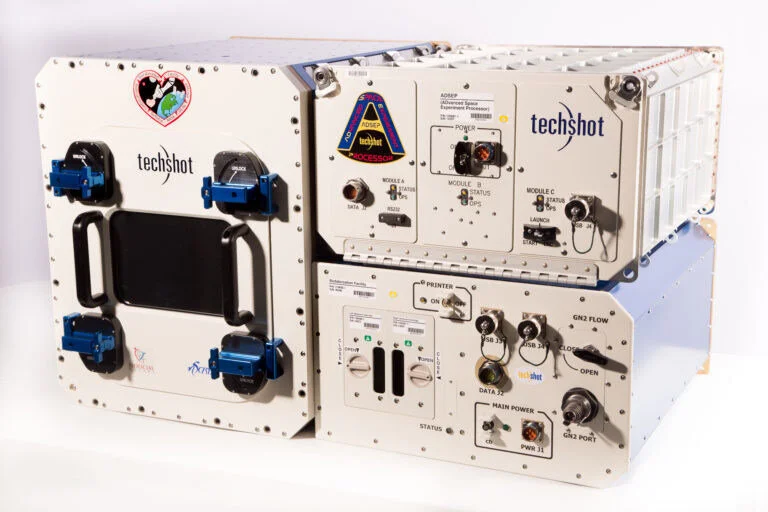A prototype plant for studying the extraction of oxygen from lunar regolith started operations recently in the Netherlands. The oxygen extraction method uses a molten salt electrolysis process to remove oxygen from regolith. This ESA based project is an enabling technology for a sustainable presence on the Moon. Being able to collect oxygen from the bountiful lunar regolith will provide a robust supply of rocket oxidizer, breathable air, and feedstock for industrial processes.
Read MoreImagine a future of transplant organs customized for each recipient, available on-demand. Instead of waiting for an organ from a donor, which could possibly take years and lead to your death due to rejection, a replacement organ could be 3D printed exactly for you. While we are not able to 3D print full organs yet, the 3D BioFabrication Facility (BFF) successfully printed a large volume of human heart cells while aboard the International Space Station (ISS), and had them recently returned to Earth.
Read MoreThe European Space Agency will be launching a debris cleaning robot in 2025. This test mission designed by ClearSpace, called ClearSpace-1, is the result of a recently signed debris removal contract with ESA. The mission will use four arms on a spacecraft to capture a 100 kg debris target, a Vespa adapter ring, which was left in an 800 km orbit after a 2013 Arianespace Vega launch of ESA’s Proba-V remote-sensing satellite. After successful capture, both the ClearSpace spacecraft and debris will re-enter and burn up in Earth’s atmosphere.
Read MoreThe UK Space Agency has a new plasma thruster in development, called Aquajet. It joins other water-based thrusters covered previously such as Bradford Space’s Comet, Tethers Unlimited’s HYDROS, and Momentus’ Vigor. Aquajet will utilize electrical current to positively charge and accelerate water ions which are then expelled from the thruster chamber at high velocity to generate thrust.
Read MoreWelcome to The Space Resources monthly newsletter for December 2019. China prepared for 2020 deep space missions with flight-worthy Long March 5, a new Mars water map, and the first public price offer for in-orbit debris removal from Iridium.
Read MoreThe Air Force wants to expand domain awareness beyond geosynchronous orbit as it becomes more crowded and competitive. They seek to develop additional capabilities for space-based assets that cut down on size, weight, power, and cost (SWaP-C). This continues the military’s overall trend away from “big, juicy targets”.
Read MoreHaving been in development for years, the Lunar IceCube spacecraft will soon be deployed in lunar orbit where it will map the distribution and dynamics of water on the lunar surface. NASA recently selected the IceCube mission to be one of the thirteen CubeSats deployed during the Artemis 1 mission in 2021. The data IceCube will collect is critical for planning future lunar ice mining missions, especially knowing where the water is on the Moon.
Read MoreBlue origin’s long-term vision is to have “millions of people living and working in space." As they test their New Shepherd capsule for space tourism and rapid reusability (NS-12 is the 6th flight of this particular booster), Blue Origin is partnering with various groups to fly fun and exciting experiments. Their NS-12 mission features Art in Space, a collaboration with the rock band OK Go to fly two student art projects.
Read MoreThe first asteroid mining missions may not happen for a decade or more, but government agencies and private companies are steadily working towards making it a reality. As some groups work the engineering and business challenges, others are looking at the scientific and legal challenges. One such challenge is dealing with debris in a microgravity environment.
Read MoreIn a talk at the SpaceCom Expo, Tom Cremins, the Associate Administrator for Strategy and Plans at NASA stated that NASA would be releasing a request for information (RFI) to industry for development of a crew capable lunar rover, to be developed in a public-private partnership.
Read MoreWelcome to The Space Resources monthly newsletter for November 2019. ESA secures record budget, Hayabusa2 on the way home, and new heavy payload providers join NASA CLPS.
Read MoreNASA recently announced that five new companies, including SpaceX and Blue Origin, are able to bid to provide payload delivery to the lunar surface via the Commercial Lunar Payload Services (CLPS) initiative. The CLPS initiative is encouraging aerospace providers to develop innovative solutions to quickly deliver future payloads to the lunar surface. Although there are now 14 providers vying for only five current opportunities, the high competition will ensure the winning bidders can provide a technically robust solution at an affordable price and acceptable time-frame. Additional opportunities are planned but not guaranteed.
Read MoreAssembling habitats and structures in space is required for enabling a sustainable human presence in space. Instead of just docking finished modules together like on the ISS, we need to be able to bolt, weld, and cut individual components to build large structures too large or fragile to be launched from Earth. Nanoracks is working to demonstrate the first ever structural metal cutting in space.
Read MoreDeep Space Industries (DSI), a subsidiary of Bradford Space, recently formalized support to build a small engineering and manufacturing center in Belval, Luxembourg. The new center will continue developing technology required for an affordable deep-space spacecraft platform. Ideally, this platform will lower the barrier for sending missions throughout the inner Solar System.
Read MoreThe Chinese National Space Administration (CNSA) wants to establish a permanent research station on the surface of the Moon. While this sentiment echoes those from NASA’s Artemis program or ESA’s Moon Village, China has a markedly different approach.
Read More













